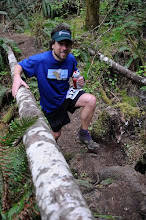Race morning arrived on one of the nicest days of the year. The Chuckanut 50km starts out and comes back along the 6 mile flat Interurban trail. I ran slow and relaxed and made sure my breathing was easier than the folks around me.
After a few miles on the Interurban trail we turned up on singletrack into some proper climbing. I worked on my power walking and enjoyed the great trail around Fragrance Lake
Finally we made the turn onto Ridge Trail. This trail is amazingly fun. It’s very technical and I passed a lot of people here. After the ridge trail the course came back on a long straight flat and gradual climb back towards AS #4. This section went on for longer than many expected. Quite a few people had run out of water and I saw one guy filling up from the creek. By the time I arrived at AS #4 I was so hungry that I barely realized it was April’s mom that was handing me food. Thanks for the help Mary and the rest of the volunteers!
The course according the Garmin, note the long out and back in lower left, and Ridge trail on top
The final climb up Chinscraper awaited. I knew what to expect since our friend Heather had taken me up this one a few months before. It was quite a grunt. Despite the near heart attack, I wasn’t able to shake the guy just behind. He was like the new Terminator in T2. I barely managed to hold him off by the time we hit the top. After AS #2 I passed about 50 people or so and was never passed.
Are you John Connor? Then I must pass you on Chinscraper trail!
After a bruising descent, presumably good downhill training for Western States, we turned back onto the flat Interurban trail for the stretch back into Fairhaven Park























